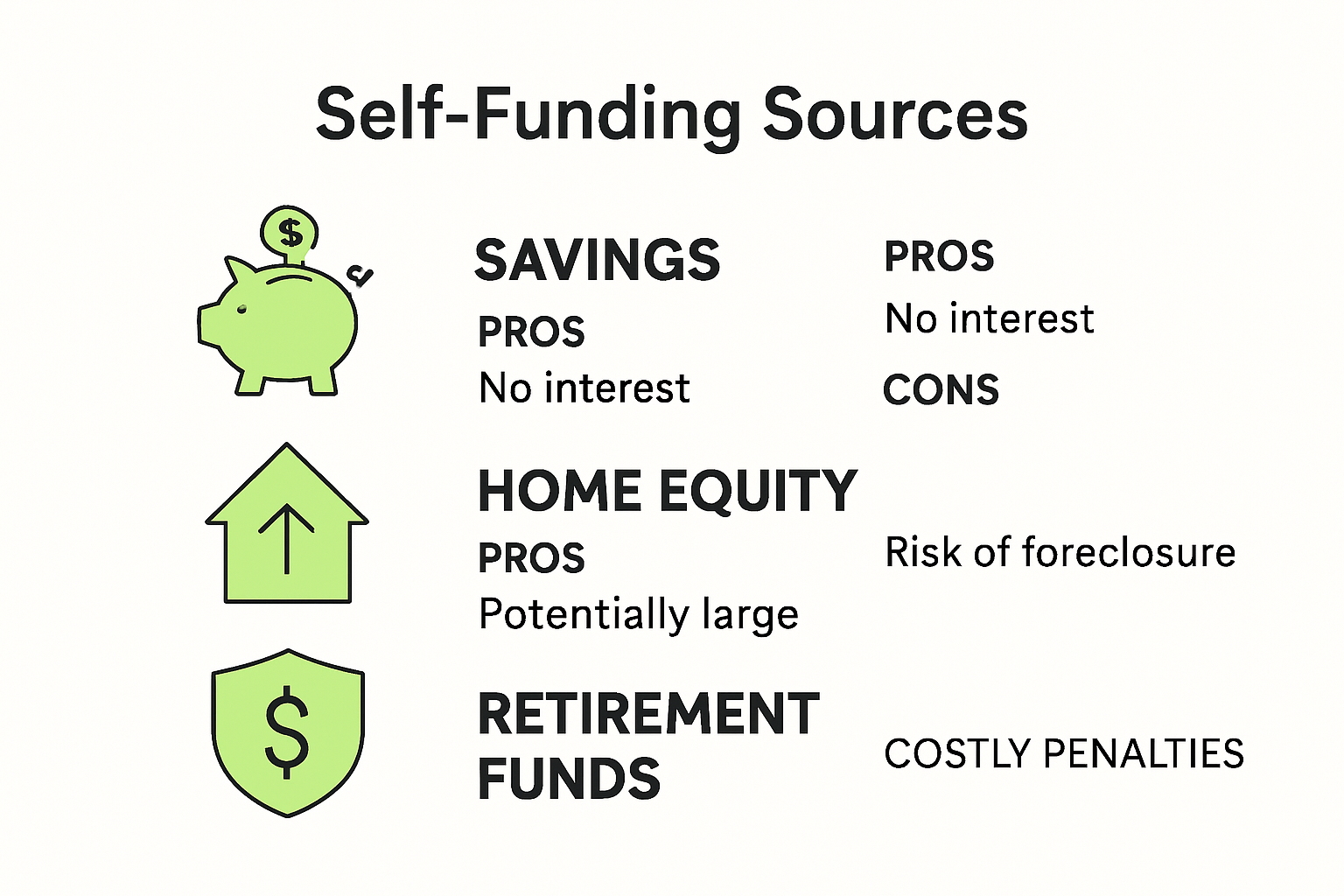
Self Funding a Business: Step-by-Step Guide for Beginners 2025
Starting a business with your own money can feel risky, especially when you realize that over 70 percent of startups are self funded in their early stages. Most people think you need outside investors or huge loans to make it work. The surprise is that beginners using simple bootstrapping methods often outperform their heavily funded counterparts by keeping full control and adapting faster. Curious how the underdog approach really stacks up?
Table of Contents
- Understanding Self Funding A Business
- The Personal Finance Foundation
- Advantages Of Self Funding
- Potential Challenges And Mitigation
- Best Self Funding Strategies For Beginners
- Bootstrapping Fundamentals
- Developing A Minimal Viable Product
- Personal Savings And Alternative Funding Approaches
- Managing Risks And Personal Finances
- Financial Risk Assessment
- Separating Personal And Business Finances
- Personal Financial Protection Strategies
- Growth Tips For Bootstrapped Founders
- Lean Startup Methodology
- Customer Development Strategies
- Strategic Partnership And Resource Optimization
Quick Summary
Understanding Self Funding a Business
Starting a business requires strategic financial planning, and self funding emerges as a powerful approach for entrepreneurs seeking complete control over their venture. Self funding a business involves using personal resources and savings to launch and grow an entrepreneurial project without external investment or loans.

The Personal Finance Foundation
Entrepreneurs choosing self funding typically leverage personal savings, assets, and financial resources as their primary capital source. Research from PLoS One highlights that personal financial commitment can significantly reduce external financing constraints and encourage more direct investment in business development.
Personal financial resources might include:
- Personal savings accounts
- Retirement fund withdrawals
- Home equity
- Personal credit lines
This approach demands careful financial planning and a realistic assessment of available resources. Entrepreneurs must balance personal financial risk with potential business opportunities, ensuring they maintain sufficient personal financial stability while investing in their venture.
Advantages of Self Funding
Self funding offers entrepreneurs unique advantages that traditional external funding methods cannot match. Research published in the Journal of Risk and Financial Management indicates that small businesses engaging in self funding often experience greater autonomy and flexibility in their innovation strategies.
Key advantages include:
- Complete ownership control
- No debt or equity dilution
- Faster decision making processes
- Reduced external reporting requirements
Moreover, studies from ResearchGate reveal that entrepreneurs frequently prefer seeking financial assistance from personal networks, demonstrating a strong preference for maintaining direct financial control.
Potential Challenges and Mitigation
While self funding presents compelling opportunities, entrepreneurs must recognize potential challenges. Limited personal financial resources can restrict business growth, potentially slowing expansion or preventing critical investments. Successful self funding requires meticulous financial management, disciplined spending, and a clear understanding of personal financial limitations.
Strategies to mitigate risks include:
- Developing comprehensive financial projections
- Maintaining emergency financial reserves
- Exploring cost effective business models
- Generating early revenue streams
Entrepreneurs must approach self funding with a balanced perspective, understanding both its potential rewards and inherent challenges. Careful planning, realistic goal setting, and continuous financial monitoring can transform personal investment into a sustainable business foundation.
Here is a table summarizing the main advantages and potential challenges of self funding a business, along with suggested mitigation strategies:
Best Self Funding Strategies for Beginners
Launching a business with limited financial resources requires strategic planning and creative approaches. Beginners can successfully self fund their entrepreneurial ventures by implementing smart, low-risk strategies that maximize personal financial potential.
Bootstrapping Fundamentals
OpenStax research defines bootstrapping as a critical self funding approach where entrepreneurs use personal savings and reinvest early profits to maintain complete business control. This method demands disciplined financial management and lean operational principles.
Effective bootstrapping strategies include:
- Minimizing initial expenses
- Reinvesting all early revenue
- Negotiating favorable vendor terms
- Using personal equipment and resources
Successful bootstrappers understand that every dollar saved represents potential business growth. They prioritize essential investments and ruthlessly eliminate unnecessary expenditures, creating a financial foundation built on efficiency and strategic spending.
Developing a Minimal Viable Product
Cloudvisor research emphasizes the importance of developing a minimal viable product (MVP) as a cost effective strategy for entrepreneurs. An MVP allows founders to test market demand with minimal initial investment, reducing financial risk and enabling rapid iteration.
Key MVP development principles:
- Focus on core product functionality
- Create low cost prototype versions
- Gather early customer feedback
- Iterate based on market response

This approach transforms limited personal financial resources into a strategic advantage, allowing entrepreneurs to validate business concepts without substantial upfront capital investment.
To help clarify, here is a table outlining key bootstrapping strategies and MVP development techniques for beginners:
Personal Savings and Alternative Funding Approaches
Additional Cloudvisor research highlights personal savings as a straightforward self funding method. However, successful entrepreneurs approach personal financial investment with calculated precision.
Alternative self funding strategies include:
- Freelancing to generate startup capital
- Selling unnecessary personal assets
- Creating side income streams
- Reducing personal living expenses
Entrepreneurs must conduct thorough personal financial assessments before committing resources. This involves understanding personal risk tolerance, maintaining emergency reserves, and creating flexible financial strategies that protect both personal and business financial health.
Self funding requires creativity, discipline, and a willingness to make strategic sacrifices. By combining lean operational principles, MVP development, and intelligent personal financial management, beginners can transform limited resources into sustainable business opportunities.
Managing Risks and Personal Finances
Self funding a business demands meticulous financial management and strategic risk mitigation. Entrepreneurs must balance personal financial stability with business growth potential, creating robust protective mechanisms to safeguard their financial future.
Financial Risk Assessment
Research from the Queensland Business Guide emphasizes the critical importance of developing a comprehensive financial risk management strategy. This involves systematically mapping potential financial risks, evaluating their probability and potential impact, and creating actionable contingency plans.
Key risk assessment elements include:
- Identifying potential financial vulnerabilities
- Quantifying potential financial losses
- Developing mitigation strategies
- Creating emergency financial reserves
Successful entrepreneurs approach risk not as a threat, but as a calculable variable that can be managed through strategic planning and proactive financial monitoring.
Separating Personal and Business Finances
The Small Business Administration highlights the critical importance of maintaining clear financial boundaries between personal and business finances. This separation provides multiple strategic advantages, including simplified accounting, enhanced financial transparency, and reduced legal complications.
Strategies for financial separation include:
- Opening dedicated business bank accounts
- Using separate credit cards for business expenses
- Implementing rigorous expense tracking systems
- Establishing clear financial documentation protocols
Entrepreneurs who maintain strict financial boundaries create a professional financial infrastructure that supports long term business sustainability and personal financial protection.
Personal Financial Protection Strategies
OpenStax research reveals that self funding entrepreneurs face significant personal financial risks, including potential total loss of invested savings and increased personal debt exposure.
Critical protection strategies include:
- Maintaining comprehensive personal emergency funds
- Limiting initial personal financial investment
- Securing appropriate business insurance
- Creating multiple income streams
- Regularly reassessing personal financial health
Entrepreneurs must approach self funding with a balanced perspective, understanding that personal financial stability is as crucial as business growth. This means implementing conservative financial strategies that protect personal assets while providing sufficient capital for business development.
Effective risk management is not about eliminating all potential challenges, but about creating flexible financial systems that can absorb and adapt to unexpected circumstances. By developing robust financial protection mechanisms, entrepreneurs can transform potential vulnerabilities into strategic opportunities for sustainable business growth.
Growth Tips for Bootstrapped Founders
Bootstrapped founders face unique challenges in scaling their businesses without substantial external funding. Successful growth requires innovative strategies, lean operational approaches, and strategic resource management that maximize limited financial capabilities.
Lean Startup Methodology
Wikipedia research on Lean Startup highlights a transformative approach for bootstrapped entrepreneurs. This methodology emphasizes developing a Minimum Viable Product (MVP) that allows founders to test market assumptions with minimal resource investment.
Key lean startup principles include:
- Rapid product iteration
- Continuous customer feedback loops
- Minimizing unnecessary development costs
- Data driven decision making
Entrepreneurs adopting this approach transform limited resources into strategic advantages, creating products that precisely match market demands while conserving financial energy.
Customer Development Strategies
Customer development research demonstrates the critical importance of systematic customer interaction for bootstrapped startups. By consistently gathering and analyzing customer insights, founders can refine their offerings without expensive market research investments.
Effective customer development techniques include:
- Conducting direct customer interviews
- Implementing lightweight feedback mechanisms
- Creating low cost prototype testing
- Utilizing social media engagement
Successful bootstrapped founders view customer interactions as valuable resources, converting every conversation into potential product improvement and market intelligence.
Strategic Partnership and Resource Optimization
Inc.com research emphasizes the power of strategic partnerships for bootstrapped businesses. By collaborating with complementary businesses and industry influencers, entrepreneurs can extend their reach without significant financial investment.
Partnership optimization strategies include:
- Identifying mutually beneficial collaboration opportunities
- Leveraging shared customer bases
- Creating cross promotion agreements
- Developing resource sharing arrangements
Bootstrapped founders who master the art of strategic collaboration can achieve exponential growth potential without traditional capital investments. These partnerships become force multipliers, enabling small teams to compete effectively against more resource rich competitors.
Growth for bootstrapped businesses is not about having massive financial reserves, but about intelligent resource allocation, continuous learning, and maintaining exceptional adaptability. By embracing lean methodologies, prioritizing customer insights, and creating strategic partnerships, entrepreneurs can transform limited resources into sustainable, scalable business models.
Frequently Asked Questions
What does it mean to self fund a business?
Self funding a business means using personal resources and savings to launch and grow a business without relying on external investments or loans.
What are the advantages of self funding a startup?
Self funding offers complete ownership control, no debt or equity dilution, faster decision-making, and greater flexibility in innovation strategies.
How can I effectively manage personal finances while self funding?
It’s crucial to maintain separation between personal and business finances, create a detailed financial plan, and regularly assess your financial health to minimize risks.
What strategies can beginners use for self funding?
Beginners can apply bootstrapping by minimizing expenses, developing a minimal viable product (MVP), seeking alternative income streams, and utilizing personal savings creatively.
Turn Your Self Funding Plan Into a Winning Business with Guided AI Support
Building a business on your own savings means you face tough choices every day as described in this guide. Balancing your personal finances with business risk can create anxiety and stall your momentum. Many founders struggle with bootstrapping because they are unsure how to create a lean startup, set the right milestones, or keep personal and business goals aligned without outside perspectives.
What if you had an AI cofounder ready to give you tailored feedback on your next step? siift helps you transform those early challenges into real progress by providing step-by-step guidance on refining your idea, developing your minimal viable product, and managing your risk. You get new insights fast so you can move forward with clarity and confidence.
Stop guessing how to invest your savings or which actions to take first. Start using siift’s platform now to personalize your self funding journey and turn your business concept into reality

see where you stand





.svg)
.svg.png)



.svg)

